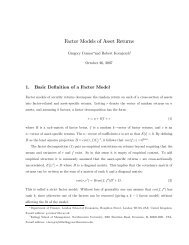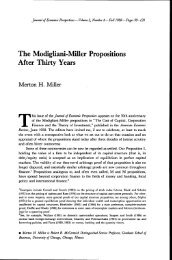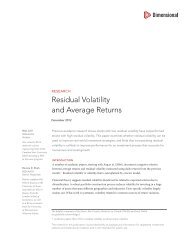Campbell, John Y, Jens Hilscher and Jan Szilagyi, 2005.
Campbell, John Y, Jens Hilscher and Jan Szilagyi, 2005.
Campbell, John Y, Jens Hilscher and Jan Szilagyi, 2005.
Create successful ePaper yourself
Turn your PDF publications into a flip-book with our unique Google optimized e-Paper software.
stocks are delisted <strong>and</strong> then re-enter the database, but we do not include these stocksinthesampleafterthefirst delisting. We treat firms that fail as equivalent todelisted firms, even if CRSP continues to report returns for these firms. That is, ourportfolios sell stocks of companies that fail <strong>and</strong> we use the latest available CRSP datato calculate a final return on such stocks.Table 6 reports the results. Each portfolio corresponds to one column of the table.Panel A reports average returns in excess of the market, in annualized percentagepoints, with t statistics below in parentheses, <strong>and</strong> then alphas with respect to theCAPM, the three-factor model of Fama <strong>and</strong> French (1993), <strong>and</strong> a four-factor modelproposed by Carhart (1997) that also includes a momentum factor. Panel B reportsestimated factor loadings for excess returns on the three Fama-French factors, againwith t statistics. Panel C reports some relevant characteristics for the portfolios:the annualized st<strong>and</strong>ard deviation <strong>and</strong> skewness of each portfolio’s excess return, thevalue-weighted mean st<strong>and</strong>ard deviation <strong>and</strong> skewness of the individual stock returnsin each portfolio, <strong>and</strong> value-weighted means of RSIZE, market-book, <strong>and</strong> estimatedfailure probability for each portfolio. Figures 2 <strong>and</strong> 3 graphically summarize thebehavior of factor loadings <strong>and</strong> alphas.The average excess returns reported in the first row of Table 6 are strongly <strong>and</strong>almost monotonically declining in failure risk. The average excess returns for thelowest-risk 5% of stocks are positive at 3.4% per year, <strong>and</strong> the average excess returnsfor the highest-risk 1% of stocks are significantly negative at -17.0% per year. Along-short portfolio holding the safest decile of stocks <strong>and</strong> shorting the most distresseddecile has an average return of 10.0% per year <strong>and</strong> a st<strong>and</strong>ard deviation of 26%, soits Sharpe ratio is comparable to that of the aggregate stock market.There is striking variation in factor loadings across the portfolios in Table 6. Thelow-failure-risk portfolios have negative market betas for their excess returns (thatis, betas less than one for their raw returns), negative loadings on the value factorHML, <strong>and</strong> negative loadings on the small firm factor SMB. The high-failure-riskportfolios have positive market betas for their excess returns, positive loadings onHML, <strong>and</strong> extremely high loadings on SMB, reflectingtheroleofmarketcapitalizationin predicting bankruptcies at medium <strong>and</strong> long horizons.These factor loadings imply that when we correct for risk using either the CAPMor the Fama-French three-factor model, we worsen the anomalous poor performanceof distressed stocks rather than correcting it. A long-short portfolio that holds thesafest decile of stocks <strong>and</strong> shorts the decile with the highest failure risk has an average19





